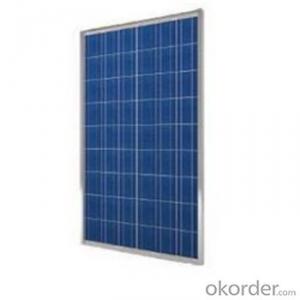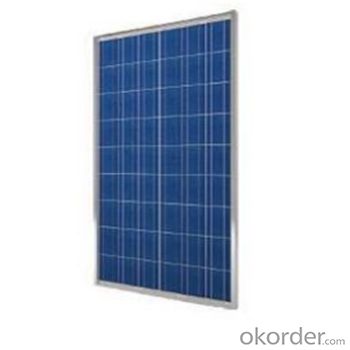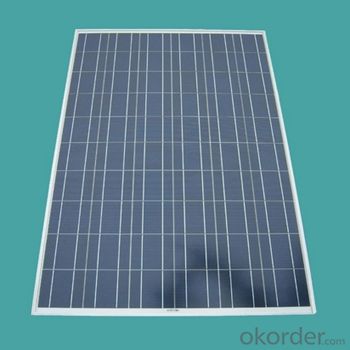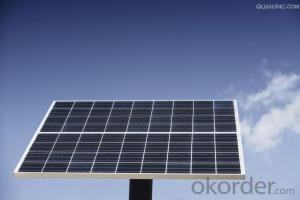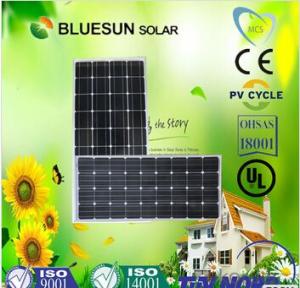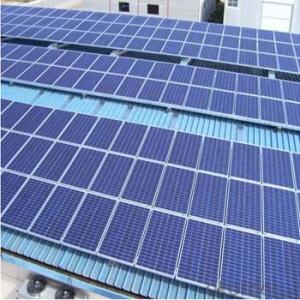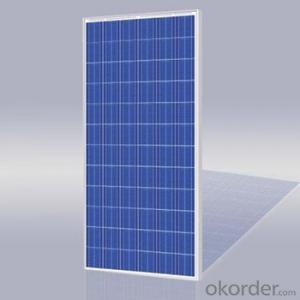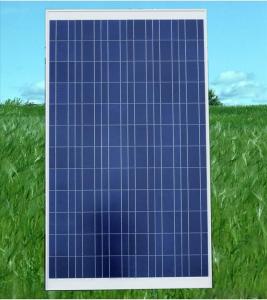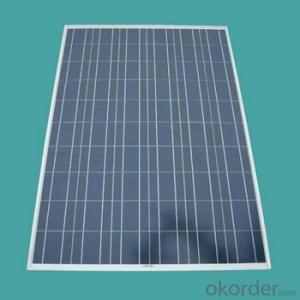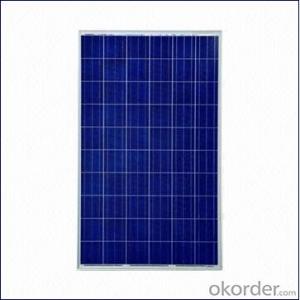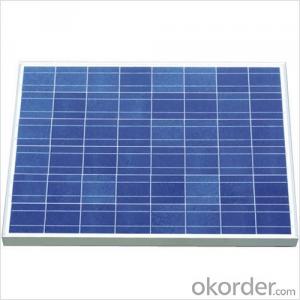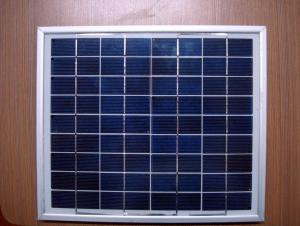Solar Panels Fort Lauderdale - Polycrystalline Solar Panels for 240w Series
- Loading Port:
- Shanghai
- Payment Terms:
- TT OR LC
- Min Order Qty:
- 25 pc
- Supply Capability:
- 100000 pc/month
OKorder Service Pledge
OKorder Financial Service
You Might Also Like
Specifications:
Structure of Polycrystalline Solar Panel for 240W Series
Polycrystalline Solar Panel for 260W l : High efficiency crystalline solar cell.
Even if under the weak light, the solar module can produce maximum power output.
II Tempered glass (toughened glass): Anti-reflecting coating and high transmission rate glass increase the power output and mechanical strength of solar module.
III EVA and TPT: Using high quality EVA and TPT to prevent destroying and water.
IV AI frame: Without screw, rner connection. 6 holes on the frame can be installed easily.
V Junction box: Multi function junction box with water proof.
VI Long lifetime: ≥25 years; Less power decrease.
VII Good performance of preventing from atrocious weather such as wind and hails.
VIII Resisting moisture and etching effectively, not effected by geology.
IX The certificate issued by international authority: UL, TUV, IEC, CE.
Standard Test Conditions of Polycrystalline Silicon Solar Panel:
The opto-electrical specifications shown below are stabilized values being measured at Standard Test Conditions, Irradiance: 1000W/m2, Spectrum: AM1.5 at 25°C, The info below is subject to manufacturing tolerances.
Where appropriate minutes of measurement are available and are used for the dimensioning of the installation.
Advantages of Monocrystalline Silicon Solar Panel
• CNBM Solar performance guarantees for 25 years
• 12 years guarantee for workmanship
• Timeliness of delivery
• Quality Products certified (TÜV, UL, CE, ISO)
Warranties
1. 10 years limited product warranty
2. 15 years at 90% of the minimal rated power output
3. 25 years at 80% of the minimal rated power output
Technical date :
ITEM NO.: | Poly 156*156 cell ,60pcs . Power range from 230Wp-260Wp | ||||||
Maximum Power(W) | 230 | 235 | 240 | 245 | 250 | 255 | 260 |
Optimum Power Voltage(Vmp) | 29.4 | 29.5 | 29.7 | 30.1 | 30.3 | 30.5 | 30.7 |
Optimum Operatige Current(Imp) | 7.83 | 7.97 | 8.08 | 8.14 | 8.25 | 8.37 | 8.48 |
Open Circuit Voltage(Voc) | 36.7 | 36.8 | 36.9 | 37.1 | 37.3 | 37.5 | 37.7 |
Short Circuit Current(Isc) | 8.52 | 8.59 | 8.62 | 8.65 | 8.69 | 8.73 | 8.78 |
Solar Cell: | 156*156 Poly | ||||||
Number of Cell(pcs) | 6*10 | ||||||
Name of Solar Cells | Polycrystalline Cell | ||||||
Size of Module(mm) | 1650*992*40/45/50 | ||||||
Cable & Connector Type | Pass the TUV Certificate | ||||||
Frame(Material Corners,etc.) | Aluminium-alloy | ||||||
Back sheet | TPT | ||||||
Weight Per Piece(KG) | 19.5KG | ||||||
FF (%) | 70-76% | ||||||
Junction Box Type | Pass the TUV Certificate | ||||||
Tolerance Wattage(e.g.+/-5%) | ±3%, or 0-3% | ||||||
Front Glass Thickness(mm) | 3.2 | ||||||
Temperature Coefficients of Isc(%) | +0.04 | ||||||
Temperature Coefficients of Voc(%) | -0.38 | ||||||
Temperature Coefficients of Pm(%) | -0.47 | ||||||
Temperature Coefficients of Im(%) | +0.04 | ||||||
Temperature Coefficients of Vm(%) | -0.38 | ||||||
Temperature Range | -40°C to +85°C | ||||||
Surface Maximum Load Capacity | 5400Pa | ||||||
Allowable Hail Load | 23m/s ,7.53g | ||||||
Bypass Diode Rating(A) | 12 | ||||||
Warranty | 90% of 10 years, 80% of 25 years. | ||||||
Standard Test Conditions | AM1.5 1000W/ 25 +/-2°C | ||||||
Packing | carton or pallet | ||||||
1*20' | 14 Pallets / 316pcs | ||||||
1*40'STD | 25 Pallets / 700pcs | ||||||
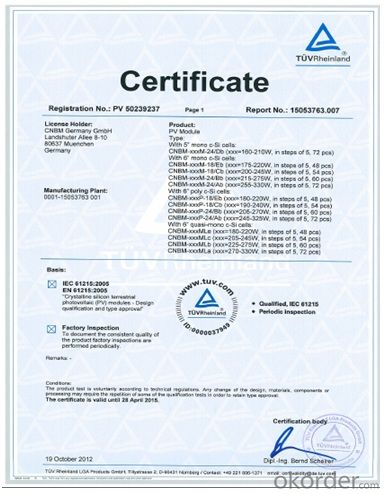
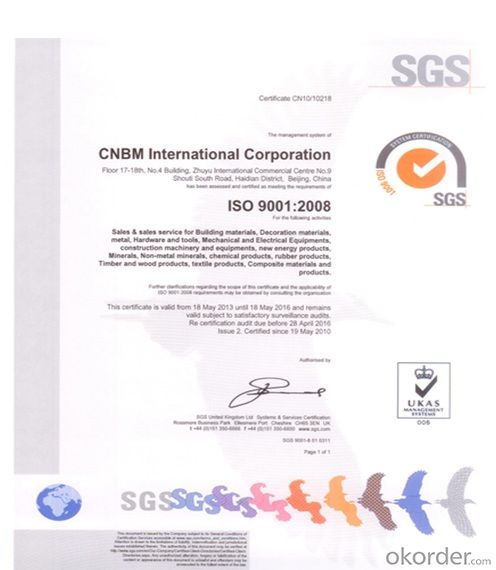
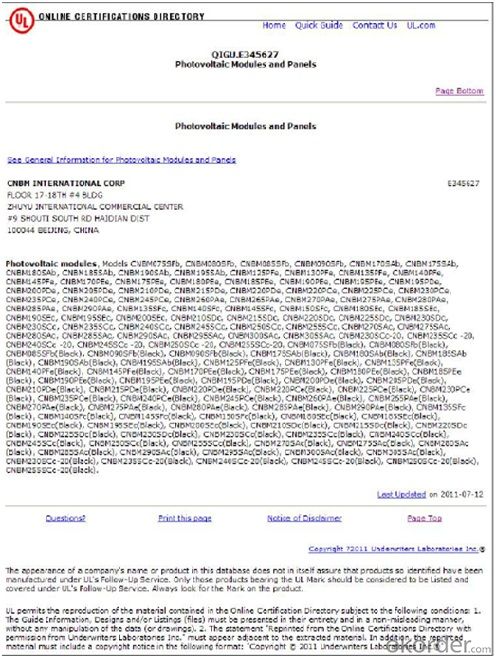

FAQ:
I..Will you focus on the safety of the goods during transportation?
Yes, Safety of the cargo is the primary element that we would consider on transportation.
II..How would guarantee the quality will meet the requirements of your clients?
Before shipment, we will have inspection for each batch of goods.
III..What certificates do you have?
IEC,UL,TUV,CSA,etc.
IV..Can you do OEM according to clients’ requirements?
Yes, we have our own brand while we can provide OEM service.
- Q: Can solar panels be installed on windows?
- Yes, solar panels can be installed on windows. There are transparent solar panels available that can be installed on windows to generate electricity while still allowing light to pass through. These panels are designed specifically for windows and can be a great way to utilize the available space for solar energy generation.
- Q: Can solar panels power a whole house?
- Yes, solar panels can power a whole house. With the right number of solar panels installed and optimal sunlight exposure, they can generate enough electricity to meet the energy needs of a typical household. However, it is important to consider factors such as the size of the house, energy consumption, and storage options to ensure a reliable and consistent power supply.
- Q: I have a small marine solar panel on my boat It came with the boat. I want to make sure it is working before I connect it. With a volt meter It is only reading .2 volts dc. I would think it should be 2-5 volts?
- If it's only reading 0.2 volts, then the panel is burned out. What you can do is look for a nameplate on the panel, then try to look it up on the internet. Hopefully that will say what the voltage is supposed to be. You are right in that a panel intended to charge a 2-volt battery should read about 8 volts open circuit out in daylight, even if it isn't pointing straight at the sun. Is it a flexible rubber panel? Those are notorious for dying after just a couple years.
- Q: How do solar panels affect the roof's lifespan?
- Solar panels can actually help extend the lifespan of a roof. They act as a protective layer, shielding the roof from harmful elements such as UV rays, rain, and snow. Additionally, solar panels can reduce the temperature of the roof, which can help prevent heat-related damage.
- Q: I don't have a regulator connected as they are a little expensive for a pensioner, If I join the panels into line to the battery bank from the roof should that be OK.?
- You can do this, but it isn't the best way to go. There is no problem with joining the solar panels. There are two ways to do this, in series and in parallel. A series combination will add the voltages that each panel is producing together, but not the amperages. For example, if five panels are producing 6V at 300mA each, the end result will be 30V at 300mA for a series array. A parallel combination combines the amperages of all the panels, but not the voltages. So, in our earlier example, five panels at 6V and 300mA would provide 6V and 500mA (.5A) if wired in parallel. Series-parallel combinations are also possible, giving some of the benefits of each method. This would probably better understood by doing a quick search on Google Images for series, parallel, and series-parallel. You CAN connect the solar panels directly to your battery bank with no regulator. Unfortunately, without a regulator, the connection is two-way. When the sun is out and the solar panels are producing more voltage than the batteries, the batteries will charge. However, when the panels are producing less voltage than the batteries, the batteries will instead send power into the solar panels, which will be dissipated and wasted. The panels may charge your batteries during the day, but they will discharge them at night.
- Q: How do solar panels affect the property's energy efficiency rating?
- Solar panels can significantly improve a property's energy efficiency rating by generating clean and renewable electricity. As they harness the power of the sun, solar panels reduce reliance on traditional energy sources, resulting in lower energy consumption and reduced greenhouse gas emissions. This increased energy efficiency positively impacts the property's overall energy performance and can potentially lead to improved ratings and lower utility bills.
- Q: My family and I are looking into solar panels for our home. But I'm unsure how it would be priced. This month our home used ,623 kwh. The solar panel company said we should expect $6-$9 per watt used. What would that put as at?
- OK, KWH stands for Thousand Watts per Hour. You used ,623,000 watt/hours last month. If you pay $6.00 per watt, your bill would be $9,738,000.00. That's right-$9 million,seven hundred and thirty-eight thousand and 00/00.
- Q: Do I just run the wire from the panel into the charge controller and then to the battery AND can I simultaneously draw energy from the battery while it is being charged by the panel?Is it as simple as hooking it up like that?
- The solar panel wires go to the charge controller. The charge controller wires go to the battery. You can also run wires from battery to a load ONLY IF it is DC load. If any AC loads, then you need a inverter to change dc to ac.
- Q: i need technical and non technical details to generate MW power by solar panels
- First off, you should consider cost per kilowatt-hour (kWh) since kWh is energy whereas MW is power, and kWh is a common unit of energy used by power utilities. But first you would need to design the power capacity required, which as you state, is assumed to be MW. Average system costs = $95 per square foot Average solar panel output = 0.6 watts per square foot Average solar energy system costs = $8.95 per watt Form this information, the capital cost of installing MW = $8.95 /W * 0^6 W/MW = $9 million. The lifetime of a typical solar power system is probably about 20 years. Assuming a true MW peak output of the solar panel it would be anticipated that a daily average energy production would be peak output over about 3 hours per day, or 3 MWh of energy per day. Total production over a 20 year system life would be 3 MWh * 365 days/yr * 20 yr = 22 x 0^3 MWh So in terms of costs of capitalization of the system, the cost of Energy (/kWh) = $8.95 million / 22 x 0^3 MWh = $0.40 / kWh (approximately) This cost does not include maintenance, however, given the simplicity of these systems; other than periodic equipment replacement, which is covered by specifying a 20 year complete system replacement; other maintenance cost should be relatively low. The required surface area of solar panel = 0^6 W / 0.6 W/ft^2 = 94,340 ft^2 or a little over 2 acres of panel surface area. To be able to properly access and maintain the solar array, the minimum area required would likely be 5 to 0 acres.
- Q: What makes them stop working after a while?
- They are used in an environment that's very harsh for semiconductors, especially the high temperatures. Ion migration and many other failure mechanisms increase with temperature. Thermal expansion adds its own mechanical stresses.
Send your message to us
Solar Panels Fort Lauderdale - Polycrystalline Solar Panels for 240w Series
- Loading Port:
- Shanghai
- Payment Terms:
- TT OR LC
- Min Order Qty:
- 25 pc
- Supply Capability:
- 100000 pc/month
OKorder Service Pledge
OKorder Financial Service
Similar products
Hot products
Hot Searches
Related keywords
